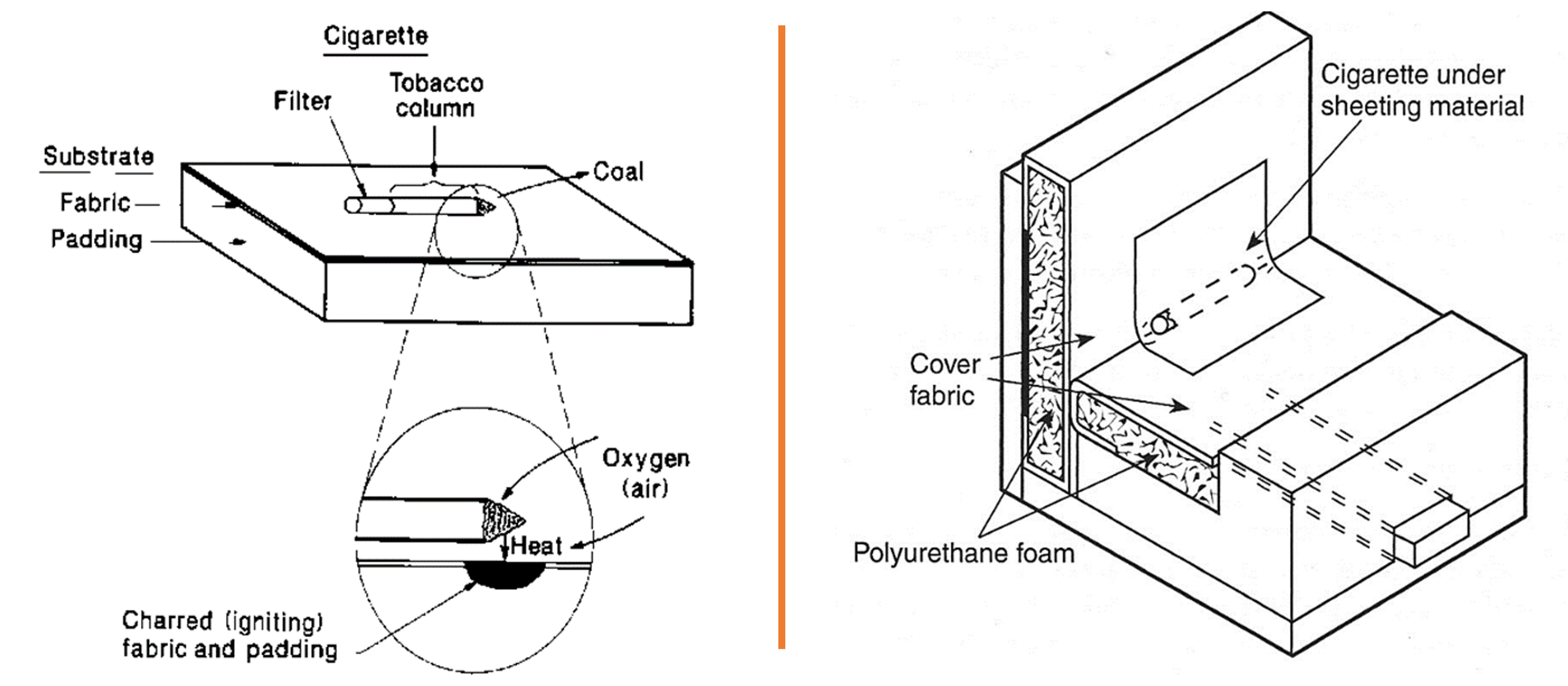Cigarette resistant furnishings (1970s)
- One of the dangers of cigarettes is their potential to start fires on furniture and mattresses.
- Making laws for safer furniture requires the ability to measure smoldering ignition resistance.
- The tests NIST developed are the basis for regulations that have led to a significant reduction in fire-related deaths.
When a lit cigarette falls on furniture, it’s hot enough to cause the fabric and padding to start smoldering. The small spot of charred material grows and generates heat, smoke and toxic gas. Even before the spot grows into a flaming fire, the gas itself can become life-threatening within 30 minutes.
It’s a frightening scenario, and at the height of cigarette use, it was all too common. Between 1971 and 1975, ignition of soft furnishings by cigarettes led to an estimated 27% of residential fire deaths in the United States.
The Consumer Product Safety Commission (CPSC) asked NIST to develop a way to test how easily a piece of residential upholstered furniture (RUF) could catch fire from a cigarette.
The first thing NIST staff members had to do was find the ideal cigarette for the test. They looked at all the available cigarettes on the market and found the one that created the most heat over the longest time.
Furniture comes in all shapes and sizes, so next they had to figure out a way to standardize the shape of the furniture they wanted to test. They decided that the best way to do it was to make a little chair, about the size of a shoebox, with each combination of padding and fabric they wanted to test.
For the test, they placed a lit cigarette in the corner of this chair model and gave the fabric and the padding separate flammability ratings.

Their test method worked. Fifty-five other laboratories tried this test, and they all got consistent results. Now that everyone could agree on a way to grade fabrics based on their flammability, this test became the basis for new regulations.
In 1975, the California Bureau of Home Furnishings (now named the Bureau of Household Goods and Services) issued TB 117, its version of the NIST test method. The furniture industry adopted a similar but voluntary standard.
In 2021, the test became a part of federal law through 16 CFR Part 1640, Standard for the Flammability of Upholstered Furniture. All new home furniture sold in the United States must now meet that standard.
A version of the test also made it into furniture for public buildings through the National Fire Protection Association’s standard, NFPA 260.
NIST researchers went on to design a similar cigarette ignition test for mattresses. This test method involved laying lit cigarettes at multiple locations across a mattress, both with and without bedsheets. They then looked to see if any of the cigarettes caused the mattress to smolder.
That research was the basis for 16 CFR Part 1632, Standard for the Flammability of Mattresses and Mattress Pads, issued by the CPSC.
Both the furniture and the mattress tests used the same off-the-shelf cigarette. But by 2010, the off-the-shelf cigarette was replaced with a special standard cigarette developed by NIST to achieve consistency of test results over time.
These regulations worked. Between 1980 and 2004, fatalities from cigarette-initiated furniture fires and from bed fires both decreased by about two-thirds. There were a few different factors that contributed to this success, from the decrease in the number of smokers to the rise of home smoke alarms, but a large portion of that decrease is undoubtably due to the regulations for furnishings enabled by NIST research.
Additional Reading:
NIST report: Backup Report for the Proposed Standard for the Flammability (Cigarette Ignition Resistance) of Upholstered Furniture, PFF 6-76, 1978.
NFPA standard: NFPA 260, Standard Methods of Tests and Classification System for Cigarette Ignition Resistance of Components of Upholstered Furniture, 2024.
Federal regulation: 16 CFR Part 1632, 1984. Standard for the Flammability of Mattresses and Mattress Pads (FF 4-72, Amended), 1984.
California regulation: Technical Bulletin 117-2013, Requirements, Test Procedure, and Apparatus for Testing the Smolder Resistance of Materials Used in Upholstered Furniture, 2013.
Journal article: Soft Furnishing Fires: They’re Still a Problem. Fire and Materials, 2021.

